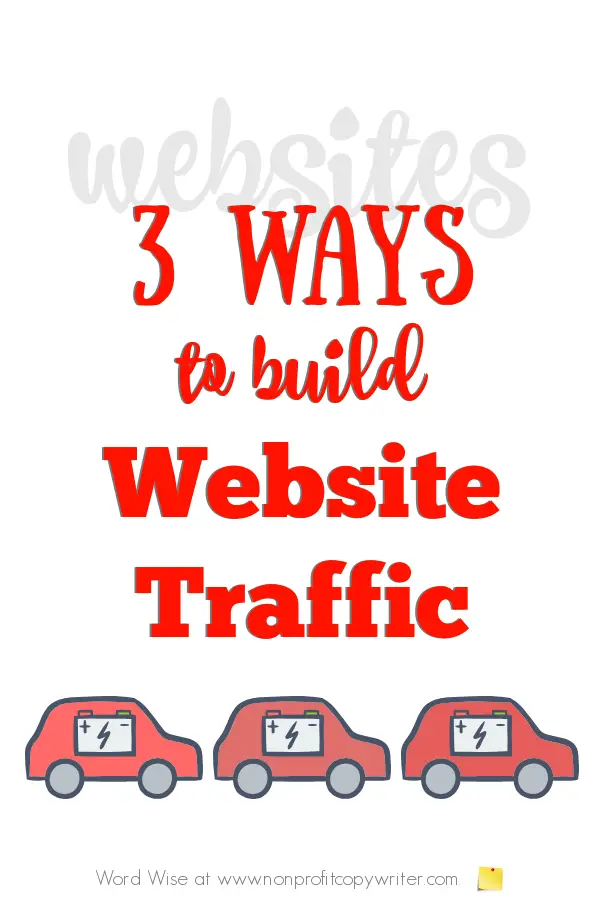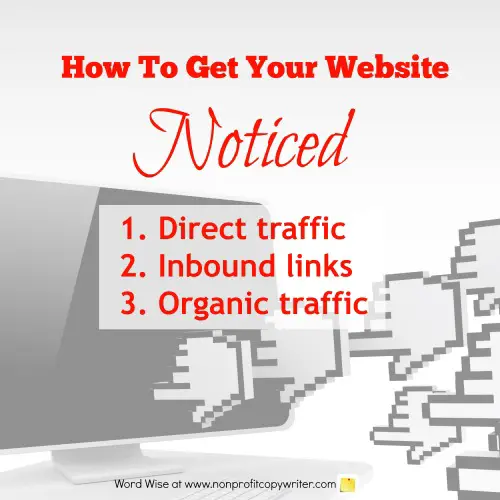Save Time: Get 5 Simple Writing Tips
you can put to use in 10 minutes
How to Get Your Website Noticed (Biz and Nonprofit Website Tip)
Award-winning writer Kathy Widenhouse has helped hundreds of nonprofits and writers produce successful content , with 750K+ views for her writing tutorials. She is the author of 9 books. See more of Kathy’s content here.
Updated 3.15.24
You've got a website or blog. And you want readers to notice it.
When people notice your website, you get traffic. And traffic means more potential customers, clients, and partners … more followers … more subscribers … and ultimately, higher sales or conversions. A well-visited website builds your brand and your authority.
But notoriety and sales are just two benefits of building traffic to your website. Once your website gets noticed, you experience an interesting phenomenon: more web traffic feeds on itself.
Here’s how it works. A user types a search term into a query box and your page appears high on the results. That user clicks on your page. As do others. All those clicks feed the search engine beasts, who see your page booming in popularity. So your link gets pushed even higher on the results.
Okay, okay – you get it. To get your website noticed, you need traffic. But if you’re just starting out – or if you’ve hit a wall– the whole "understanding how to get to the top of the results page" is confusing for you. How do you build traffic to your website?
Here’s a simple way to understand it.
Understand how website traffic works
If you want your website to get noticed, you need to understand how traffic works online. And the simplest analogy is traffic on the highways.
Why does traffic grow on the streets around you? Because more vehicles fill the roads. Those vehicles are filled with 3 main kinds of people.
- People who live in your area.
- People who live elsewhere but come to your area for work or activities.
- People who find your area while they are passing through.
The same is true for people who find your website on the web.
Online, traffic grows when there are “vehicles” on the “road.” “Vehicles” are users and the “road system” is the internet. These users choose a particular road to drive on – a page to click on – for one of three reasons:
- Your site is like a “home” to them – they know the address (direct traffic).
- Your site is a place they travel to for work or activities (inbound traffic).
- Your site is a place they find while they are passing through (organic traffic).
When you understand these 3 types of website traffic, you can use each of them to help get your website noticed. Your site can get traction. And guess what? You can do it for low cost … or even for free.
3 ways to get your website noticed
1. Direct Traffic
Direct traffic refers to visitors who come to your website by directly typing your website's URL into their browser or using a bookmark to access your site. In other words, these are users who are familiar with your website and access it without clicking on a link from another website, search engine, social media platform, or online advertisement. Direct traffic can also include visitors who click on a link in an email or messaging app that leads directly to your website.
For example, let’s say you’re ready to do some online shopping. You type www.amazon.com directly into your browser. In this instance, Amazon is like a “home.” Your reader knows the address. She’s familiar with the site. She’s a fan!
Think back to our analogy. Traffic grows when your local area grows, too. Resident who live in your area fill the roads. Likewise, direct traffic to your site grows when users know your site and consider it to be a “home” for them.
You can help get your website noticed when you find ways to build direct traffic to your website.
Ways to build direct traffic
- Include your web address on all printed matter (letterhead, brochures, newsletters, annual reports).
- Cite your web address on your organization’s voice mail message.
- List your web address on every employee’s email signature.
- Build your brand through consistent messaging.
- Build your brand through consistent formatting. Choose 1 or 2 colors for your content and stick with them. Ditto for your fonts.
- Encourage satisfied customers to refer others to your website through word-of-mouth recommendations.
- Collaborate with other businesses or influencers who can promote your website to their audience.
- Invite users to bookmark your page.
- Send email. Build and maintain an email list to regularly communicate with your subscribers. But only send a snippet or teaser to your latest post. Then, link back to your site to drive traffic to your online home.
2. Inbound Links
Unlike direct traffic, which involves users directly accessing your website by typing the URL or using bookmarks, inbound traffic is generated through external links or referrals that lead users to your site.
The reader sees a link to your site somewhere online (whether on another site, in a blog, or on a social media post) and is interested in learning more. He clicks on the link and is led to your site.
Remember the analogy? Some people travel to your town for work or activities. In the same way, some users travel to your site (click on it) not because they live there, but for work or activities. In this case, for information.
Inbound links are also called backlinks, incoming links, one way links, or external links. The link can connect to your site from anchor text, images, videos, or buttons.
No matter how the user ends up on your page, content is the vehicle that gets her there. Inbound links of all kinds build traffic because they lead more visitors to your pages.
But inbound links have a double value. They act like "votes of confidence" from one website to another, indicating to search engines that the linked-to website is reputable, valuable, and relevant. Pages with a high number of relevant backlinks tend to have high organic search engine rankings.
You can help get your website noticed when you find ways to build inbound traffic to your website.
Ways to build numbers of inbound links
- Add your website to online web directories, industry-specific portals, review sites, and local business listings.
- Exchange links with like-minded websites, businesses, and organizations. You’ll get referral traffic through backlinks, mentions, or recommendations.
- Post on niche forums, message boards, and blogs about your topic and include a link to the appropriate page on your website.
- Publish online articles and cite your website address.
- Post on social media. Use platforms like Facebook, Twitter, Instagram, and LinkedIn to share engaging content, images, videos, promotions, and updates – even teasers – that lead users back to your website.
- Produce high quality, shareable content such as blog posts, videos, infographics, and podcasts that attract visitors and encourage sharing.
3. Organic Traffic
Organic traffic refers to the visitors who come to your website through unpaid, natural, and non-advertising channels.
These visitors find your website through search engine results pages (SERPs) when they enter relevant keywords or phrases related to your content, products, or services. Your site comes up in the search engine results page (hopefully near the top – not buried on the sixth page – if your site is optimized). The reader sees the brief description about the page on your site that contains that term and clicks on your link.
Organic traffic is like drivers who are “passing through.” They see a sign or notice your town and stop because it’s intriguing, meets a need, or pulls them in. Online, those users notice your link and click on it because it’s optimized to answer their question or provide the information they need.
You can help get your website noticed when you find ways to build organic traffic to your website.
Ways to build organic traffic
- Use resources like Google’s Keyword Planner and Wordtracker to find out what terms related to your niche are most-searched online. (These terms are called your “keywords.”)
- Use SEO (search engine optimization) to choose and use keywords on each page of your site. You’ll improve visibility help make your website attractive to the search engines.
- Optimize for mobile. Websites that load quickly and that are optimized for mobile are ranked higher on search engines. Plus, they offer a better user experience … which will motivate your reader to come back to your site again and again, building your traffic.
- Strategically place your keywords on your site. Include them in your page titles, on navigation bars, in page headlines, in body content (especially in the first 80 characters), graphics ALT tags, and page descriptions. This will help “optimize” your site for the keywords important in your niche and boost your rankings on search engine results.
- Create internal text links within your site. Write into the body copy links from one page of your site to another using your keywords.
The best tip for getting your website noticed
You can used paid advertising to build traffic. Visitors click on paid ads displayed on search engines, social media, websites, or other online platforms that lead them to your website. Or you can use traditional advertising methods like print ads, radio spots, or direct mail to drive traffic to your website. But unless you have a large advertising budget, the paid approach is difficult to sustain.
Best website tip for getting noticed: do an excellent job of making all three kinds of traffic attractive to readers.
- Check your website traffic data regularly to see how your site is performing.
- Use Google Analytics or your website’s statistical application to track how people find you on the web.
- Then, work to improve your results. For instance, if only a small percentage find you through inbound links, then start posting on topic-related forums or start a Facebook page to drive more traffic to your site.
There are dozens of ways for people to find you online when you understand how web search works. So get out there, produce fantastic content – and get noticed.
More Writing Tips for Websites
12 Tips for Writing Website Content That’s Easy to Read ...
Pillar Pages: what they are and why you need to write them ...
The 3 Types of Links Your Website Needs and How to Build Them ...
How to Build a Content Writing Strategy for Your Blog or Website ...
The 6 Pages You MUST Have on Your Writing Website ...
3 Things You Need for Planning a Website (or Updating One) ...
Writing Content For a Website: Write These 3 Pages First ...
Top 10 nonprofit website tips ...
3 Simple Tips for Writing Better Web Pages ...
What Is SEO Content Writing? Tips for Strong Search Results ...
Terms You Need to Know for Writing Website Content: A Glossary ...
Make a P-L-A-N for Your Website Content Writing ...
How to Write More Powerful Lead Magnets: 5 Easy Steps ...
10 Writing Tips for Your Website About Page ...
The Top Online Copywriting Tip ...
Review: Website Hosting with SBI (Solo Build It) ...
3 Tips for Writing Homepage Content: A Quick Tutorial ...
What your nonprofit webpage must have ...
The 4-letter word your nonprofit website needs ...
Nonprofit website checklist: 10 items you need on your website template
Writing Websites Tips on our Pinterest board ...
Free nonprofit website checklist ...
Return from Nonprofit Website Tip to Nonprofit Copywriter home
As an Amazon Associate I earn from qualifying purchases.
Share This Page

Named to 2022 Writer's Digest list
BEST GENRE/NICHE WRITING WEBSITE


Stop Wasting Time!
Grab your exclusive FREE guide, "5 Simple Writing Tips You Can Put to Use in 10 Minutes or Less"














